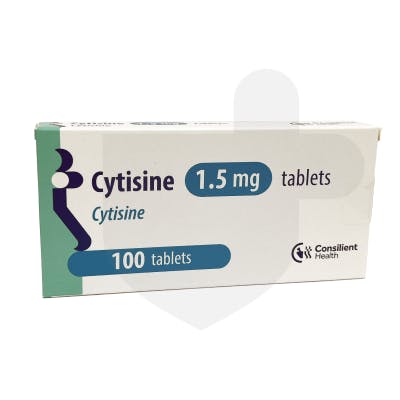Smoking cessation
Treatment & Medications
With NowPatient's private treatment plans you can treat Smoking cessation safely and easily in a few simple steps. Get started by selecting the available treatments you are interested in below or by hitting the start consultation button.
This content is intended for UK audiences only
Available treatments
Compare treatments
Get started with the right treatment for you
Treatments & Medications
delivery
service

Smoking stands as a major global health challenge, contributing to over seven million deaths annually and if trends persist, this figure is projected to rise above eight million by 2030. The key players in smoking-related mortality include health conditions such as atherosclerotic cardiovascular disease, lung cancer, and chronic obstructive pulmonary disease (COPD), making it imperative for individuals and healthcare professionals to prioritize smoking cessation. Recognizing its health impacts is crucial, not only for general well-being but also for reducing risks in specific areas such as pregnancy, erectile dysfunction, and chronic respiratory conditions like bronchitis and asthma.
This article aims to guide individuals through the cessation process, highlighting the significant benefits of quitting smoking, from improving pancreatic health to reducing the risk of coronary heart disease. It offers effective strategies to stop smoking, outlines local stop smoking services available in healthcare, and provides insights into overcoming relapses. Each section, backed by current healthcare practices and research, will empower readers with the knowledge and resources required for successful smoking cessation, moving towards a healthier, smoke-free life.
Understanding the challenges of quitting
Understanding the challenges of quitting smoking is an essential step in the journey towards a smoke-free life. Those who decide to quit often face a range of obstacles:
- Nicotine withdrawal: Individuals can experience a variety of withdrawal symptoms such as irritability, anxiety, and difficulty concentrating. These symptoms are a significant hurdle but are temporary, usually subsiding within a few weeks
- Cravings and triggers: Cravings for a cigarette can be intense, often triggered by stress or mood swings. However, these cravings typically last only three to five minutes. Recognizing and preparing for these moments can be crucial in resisting the urge to smoke
- Relapses: It’s important to understand that slips and relapses are a normal part of the quitting process. Learning from each attempt is vital, as most people try quitting several times before they succeed
Incorporating smoking cessation strategies, such as quit-smoking medications and therapies, can greatly assist in managing cravings and withdrawal symptoms. Additionally, adjusting to daily routines without smoking takes time due to the strong association between habits and smoking. Factors such as age, education level, and marital status can also influence one’s motivations and challenges in quitting.
It’s also common to experience weight gain and appetite changes after quitting, but maintaining focus on the end goal and adopting healthy habits can mitigate these issues. Persistence and preparation for nicotine withdrawal symptoms and triggers increase the chances of successfully quitting. Healthcare professionals can provide valuable support by discussing the risks of smoking, the benefits of quitting, and guiding through the proper use of cessation aids.
Benefits of quitting smoking
Quitting smoking unleashes a multitude of benefits that enhance both the longevity and quality of life. For instance, within just 20 minutes of stopping smoking, heart rate and blood pressure drop, and the journey to improved health begins. Here are some key advantages of quitting smoking:
- Health recovery: The body starts repairing itself almost immediately. Long-term benefits include a dramatic decrease in the risk of heart attack and cancer, with some risks halving within a year of quitting. Moreover, quitting smoking can add as much as 10 years to a person’s life expectancy, underscoring the profound impact on longevity
- Financial gains: The monetary benefits are also significant, with the average smoker saving approximately £38 a week, which amounts to around £2,000 a year. This can translate into substantial savings that can be redirected towards healthier lifestyle choices or savings goals
- Enhanced physical and mental health: Improved senses of taste and smell, easier breathing, and increased energy levels are noticeable shortly after quitting. Additionally, individuals experience reduced anxiety, depression, and stress, leading to an increase in positive mood compared to those who continue smoking
- Family health: The health benefits extend to family and friends, reducing non-smokers exposure to secondhand smoke and decreasing the likelihood of children taking up smoking. Quitting smoking before or early in pregnancy can significantly reduce the risk of adverse reproductive health outcomes, offering a healthier start for the next generation
Incorporating a systems approach that includes interventions for tobacco use relapse prevention, dietary modifications, and reduced alcohol intake can amplify these benefits, further improving health outcomes for ex-smokers. The decision to quit smoking is a powerful step towards a healthier, more fulfilling life for individuals and their loved ones.
Effective strategies for smoking cessation
Embarking on the journey to quit smoking is a commendable decision, and there are several effective strategies that can support this goal:
- Find personal motivation: Identifying a strong personal reason to quit smoking, whether it’s for improving health, saving money, or protecting loved ones from secondhand smoke, can fuel the commitment needed throughout this challenging process. Write down these motivations and refer to them to stay focused
- Prepare a quit plan: Set a quit date and get ready by exploring support options like quit-smoking classes, apps, counseling, and medications. A clean environment can also help, so consider removing all smoking paraphernalia from your home
- Nicotine replacement therapy (NRT): Using NRT products such as patches, gum, lozenges, inhalers, electronic cigarettes or vaping can help manage withdrawal symptoms and cravings, making the quitting process more bearable. These are more effective when combined with a structured quit-smoking program
- Prescription medications: Consult with a healthcare provider about prescription options like bupropion and varenicline, which can reduce cravings and make smoking less satisfying
- Support network: Inform friends, family, and colleagues about your quit attempt. Their encouragement can be invaluable, especially during moments of temptation
- Physical activity: Regular exercise can not only distract from cravings but also reduce withdrawal symptoms. Even short walks or stretches can make a difference
- Healthy diet: Eating well-balanced meals with plenty of fruits, vegetables, whole grains, and lean proteins can improve overall health and help manage weight after quitting
- Delay tactics: When cravings hit, wait for at least 10 minutes. Use this time to distract yourself with a different activity or practice deep breathing exercises
- Healthy substitutes: Keep your mouth busy with sugarless gum, hard candy, or crunchy snacks like carrots or nuts instead of reaching for a cigarette
- Avoid ‘Just One’ trap: Resist the temptation to smoke ‘just one’ cigarette. Often, this leads back to regular smoking
- Stress management: Find alternative ways to handle stress, such as meditation, yoga, or listening to calming music
- Seek professional help: Utilize resources like the NHS Stop Smoking Services, which offer various treatments and support options, including NRT, prescription medications, and e-cigarettes
- Learn from past attempts: Reflect on previous quit attempts to understand what worked and what didn’t, and adjust your strategy accordingly
Remember, quitting smoking is a journey, and it’s okay to seek help along the way. Whether it’s through behavioral changes, NHS Stop Smoking Services, or Smokefree Smartphone Apps, there are numerous tools and strategies available to support your smoke-free life.
Support systems and resources
Support from friends, family, and healthcare professionals plays a pivotal role in the journey towards smoking cessation. Here are some key resources and support systems that can aid individuals in their quest to quit smoking:
- Healthcare professional guidance: Consulting with a GP, pharmacist, or health visitor in England, Scotland, or Wales can provide access to Stop Smoking Advisers through referrals. These professionals can offer personalized advice and support tailored to individual needs
- Digital support tools: The NHS Quit Smoking App is a useful resource for tracking progress, visualizing savings, and receiving daily support. Additionally, resources like the CDC’s (Centers for Disease Control and Prevention) quitSTART App offer assistance in managing withdrawal symptoms
- Community and online support: A variety of support options are available, including free local services that can be accessed via phone or video call. The NHS offers 28 days of email support, a Quit Smoking Support Group on Facebook, and the National Smokefree Helpline for ongoing encouragement
- Specialized resources: Organizations like the American Cancer Society and Smokefree.gov provide tools and guides tailored for different demographics, ensuring everyone has the support they need. These resources are often available in PDF format for easy viewing and printing, making them accessible to a wider audience
By leveraging these support systems and resources, individuals seeking to quit smoking can enhance their chances of success and maintain a smoke-free lifestyle.
Overcoming relapses
In the journey of quitting smoking, encountering relapses is a common hurdle. However, each relapse provides a unique opportunity to learn and strengthen one’s resolve. Here’s how to navigate through and overcome relapses effectively:
- Reflect on the cause: Understanding what led to the relapse is crucial. Was it a stressful day at work, or perhaps a social event with other smokers? Reflecting on the cause can turn the experience into a learning opportunity, reinforcing the commitment to quit smoking for good. Reflect on the cause and use it as an opportunity
- Identify and manage triggers: Triggers can be emotional, related to certain patterns, social settings, or even withdrawal symptoms. Recognizing these triggers is the first step in managing them effectively. Here are some common triggers and ways to handle them:
- Emotional: Stress, anxiety, or sadness. Technique: Practice deep breathing or mindfulness
- Pattern: Smoking after meals or with coffee. Technique: Change your routine or environment
- Social: Being around other smokers. Technique: Avoid such settings or prepare with NRT
- Withdrawal: Urges to smoke. Technique: Use delay tactics like drinking water or a 10-minute walk
- Engage with support: Sharing the experience of a relapse with a family member, friend, or support group can provide encouragement and accountability. It’s important to remember that quitting smoking is a process, and support from others can make a significant difference in maintaining a smoke-free life. Telling a family member or friend about a relapse can bolster support and motivation
By addressing the cause of a relapse, identifying and avoiding common triggers, and seeking support, individuals can navigate through relapses more effectively, keeping their goal of stopping smoking within reach.
Conclusion
Throughout this article, the journey towards achieving a smoke-free life has been thoroughly explored, emphasizing the significant health, financial, and personal benefits that come with quitting smoking. From understanding the challenges and effective strategies for cessation to leveraging support systems and navigating through relapses, it is clear that the path to quitting smoking is multifaceted and requires a comprehensive approach. This article has underscored the importance of personal motivation, preparedness, and the utilization of available resources and support, highlighting that success in quitting smoking is attainable with persistence and the right strategies.
As individuals embark on or continue their journey towards smoking cessation, it is important to remember the profound impact this decision has not only on their own lives but also on the well-being of their loved ones. The road might be challenging, but the benefits are undeniably worthwhile, offering a healthier, longer life and the opportunity to set a positive example for future generations. For those seeking further assistance and support, exploring NHS Stop Smoking Services and Smokefree Smartphone Apps can provide additional guidance and encouragement. Remember, every step taken towards quitting smoking is a step towards a healthier, smoke-free future.
FAQs
What are the essential steps in a smoking cessation intervention?
The essential steps in a smoking cessation intervention are known as the “5 A’s”: Ask, Advise, Assess, Assist, and Arrange. This approach involves identifying smokers and providing appropriate interventions based on their readiness to quit. It’s important to document the tobacco use status of every patient during every visit.
What does a smoking cessation service entail?
A smoking cessation service provides ongoing consultations that include behavioral support and the provision of Nicotine Replacement Therapy (NRT). These services are delivered by pharmacists who have received appropriate training in smoking cessation.
What are the 5 R’s related to smoking cessation?
The 5 R’s of smoking cessation are strategies designed to complement the 5 A’s approach. They include Relevance, Risk, Rewards, Repetition, and Roadblocks. This method, which can take between five to fifteen minutes, has been globally recognized for its effectiveness in helping individuals quit smoking.
What is the most effective method to quit smoking permanently?
The most effective method for quitting smoking involves a combination of using quit-smoking products such as nicotine patches, lozenges, gum, inhalators, nasal sprays, stop smoking tablets such as bupropion, and participating in a support program. This program should be led by professionals trained in treating tobacco dependence. Options include joining a community stop-smoking group or engaging in in-person or telephone counseling.
Sources
Medical Disclaimer
NowPatient has taken all reasonable steps to ensure that all material is factually accurate, complete, and current. However, the knowledge and experience of a qualified healthcare professional should always be sought after instead of using the information in this page. Before taking any drug, you should always speak to your doctor or another qualified healthcare provider.
The information provided here about medications is subject to change and is not meant to include all uses, precautions, warnings, directions, drug interactions, allergic reactions, or negative effects. The absence of warnings or other information for a particular medication does not imply that the medication or medication combination is appropriate for all patients or for all possible purposes.
What is NowPatient
Telehealth and Online Pharmacy
NowPatient is a licensed online pharmacy and doctor service that is available around the world. Our service is FREE and packed with valuable features that can benefit your health such as medication reminders, educational blogs, medically approved symptoms checker, UK NHS online pharmacy, private treatment plans, Rx Advantage card, health conditions information, affordable medications options, genetic testing, home test kits, health risks, pollen meter, air quality monitor, weight loss plans, drug savings programs and lots more!

WHY WE BUILT NOWPATIENT
To improve the lives of everyone by making high-quality care accessible and convenient
We are here to improve lives. Our service gives you access to smart features and resources that can help empower you to take control of your health and improve your health outcomes. All this, in one place, for FREE. We strive to bring a fresh perspective to managing health. NowPatient can be accessed by downloading the App or using your web browser.
Download our app today

Can I trust NowPatient
Meet our medical team
We are a passionate group of clinicians and medical writers covering a broad range of specialities with experience operating in health systems in the United Kingdom & United States. Providing excellent care and advice is at the heart of everything we do. You can read more about our medical team by visiting the medical team page or learn more about how we curate content by visiting our editorial process

